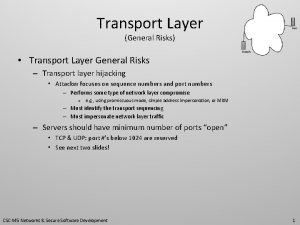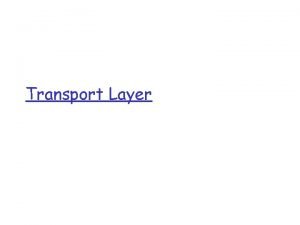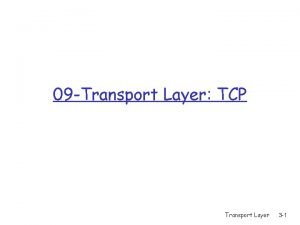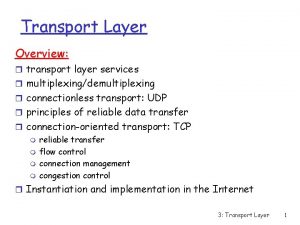Transport Layer General Risks Transport Layer General Risks








- Slides: 8

Transport Layer (General Risks) • Transport Layer General Risks – Transport layer hijacking • Attacker focuses on sequence numbers and port numbers – Performs some type of network layer compromise » e. g. , using promiscuous mode, simple address impersonation, or Mit. M – Must identify the transport sequencing – Must impersonate network layer traffic – Servers should have minimum number of ports “open” • TCP & UDP: port #’s below 1024 are reserved • See next two slides! CSC 445 Networks & Secure Software Development 1

Transport Layer (General Risks, cont’d) • Transport Layer General Risks (cont’d) – Static vs dynamic port assignment • Client connection initially made to known server port number • Client port number may be dynamic (selected from range of numbers) – Client must include dynamic port number in its request • Dynamic ports used when app spawns processes for managing network traffic – Creates a security risk since large port range must be accessible to network • Firewalls – Configure port numbers to allow or prevent network access – Can permit all higher (> 1023) port numbers » Huge vulnerability – When using only static ports, can prevent access to unused ports CSC 445 Networks & Secure Software Development 2

Transport Layer (General Risks, cont’d) • Transport Layer General Risks (cont’d) – Port scans • Attacker looking for an “open” port – Targeted port scans » Scan same port number across range of IP addresses – Port sweep » Scan all port numbers for same IP address • Mitigation – Use nonstandard port numbers – Use a “no reply” defense » BSD systems do not reply to packet requests when port is inactive – Use an “always reply” defense » Have system reply to every packet request, whether port is active or not CSC 445 Networks & Secure Software Development 3

Transport Layer (UDP Risks) • Unvalidated inbound source – Any host can connect to UDP server • e. g. , any type of UDP packet can potentially flood a server • UDP hijacking – Since UDP packets do not have sequence numbers, can guess port number (only 65, 535; takes a few seconds) • UDP keep-alive attack – UDP server ports closed after period of inactivity • e. g. , attacker can hold open a UDP port; tries to keep open many ports, possibly preventing other ports from opening • UDP smurf attack – Flood remote network with packets • e. g. , attacker forges victim’s network address as sender CSC 445 Networks & Secure Software Development 4

Transport Layer (TCP Risks) • TCP reconnaissance – Operating system profiling • Determine the OS and its patch level – Port scans • Attempt to connect to a port – Four types of replies » » SYN-ACK RST ICMP unreachable Nothing positive identification that service running on port typically confirms no service on port indicates failure to reach host/server cannot determine status of port – Mitigation • Log network activity e. g. , connection requests CSC 445 Networks & Secure Software Development 5

Transport Layer (TCP Risks, cont’d) • TCP hijacking – Any attack that interferes with a TCP connection • Full session hijacking – Attacker tells client to disconnect but then acts as client to the server » Fairly rare, typically requires attacker to have direct link layer access • ICMP – Internet Control Message Protocol – ICMP used to report unsuccessful connections – Used maliciously, can redirect TCP connections to different ports CSC 445 Networks & Secure Software Development 6

Transport Layer (TCP Risks, cont’d) • TCP Do. S (Denial of Service) – SYN attacks • Send large number of SYN packets in order to consume all available memory on server – RST and FIN attacks • Abnormally terminate a connection – ICMP attacks • Terminate a connection – LAND attacks • Send SYN to server – Packet source IP address and port matches server’s address and port » i. e. , Server is in a feedback loop CSC 445 Networks & Secure Software Development 7

Transport Layer (TCP Risks, cont’d) • Mitigation options – Alter system profile • e. g. , change SYN timeout, retry counts, retry durations, initial window size, available TCP options, initial sequence values – Block attack vectors • Use a firewall – Identify network devices • Some devices may be more vulnerable to certain types of attacks – Stateful packet inspection • Track state of TCP connections; reject packets that do not match known state – E. g. , silently drop an RST sent to a closed port – Intrusion detection system • Monitor network for nonstandard or unexpected packets – Intrusion prevention system • Tries to actively disable attack vectors – Higher-layer protocols • App-layer should authenticate traffic and detect potential attacks CSC 445 Networks & Secure Software Development 8















